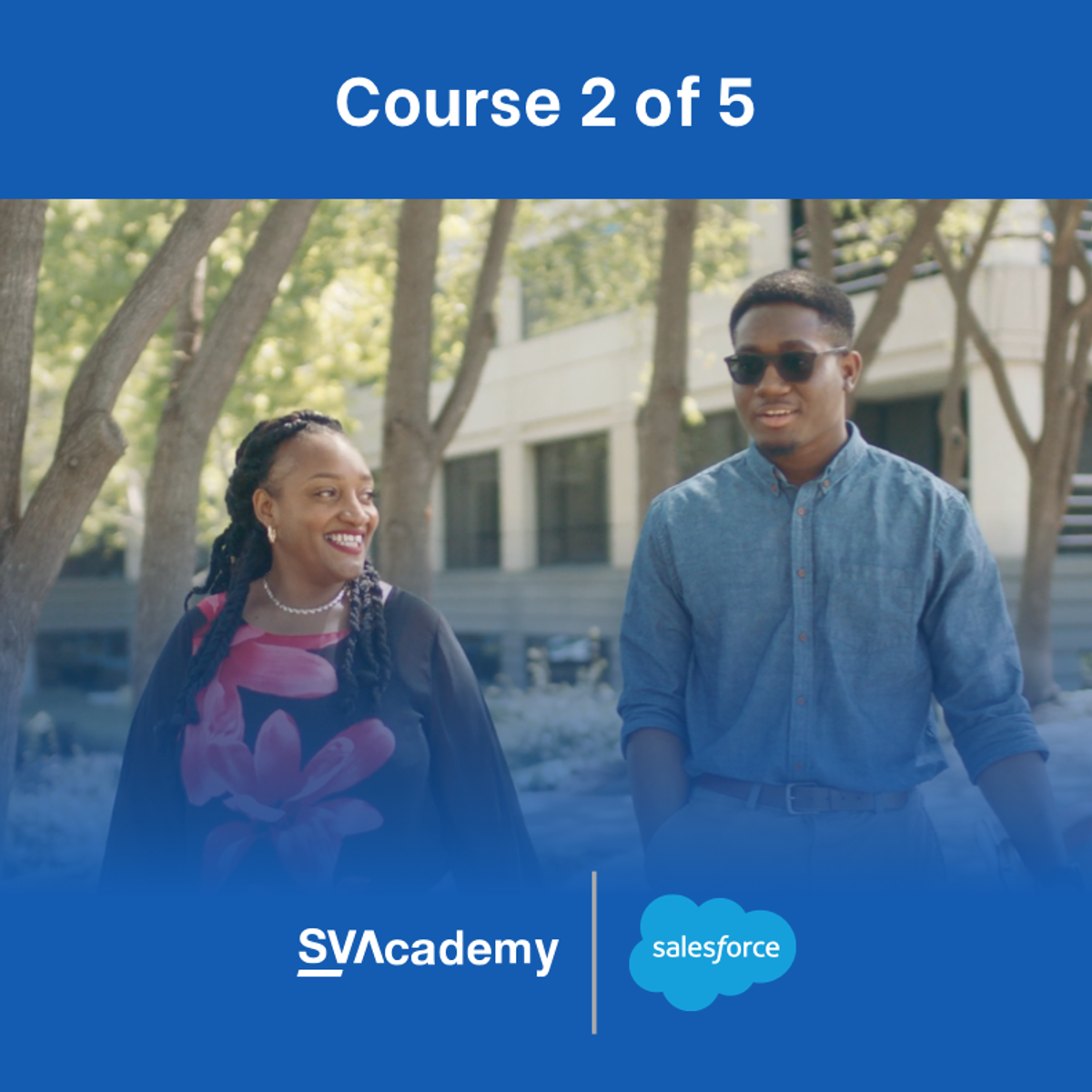Back to Courses









Business Essentials Courses - Page 55
Showing results 541-550 of 645

Foundations for Interviewing with Confidence
This is Course 2 in the Salesforce Sales Development Representative Professional Certificate. In order to successfully complete the course, please ensure you have taken Course 1: Groundwork for Success in Sales Development.
The goal of this course is to prepare you to build your professional tech sales portfolio, and develop and leverage your personal and professional brand. You will be primed to ace your interview and leave a lasting impression on your future employer. These skills will get you in the door of a fast-growing tech company and launch your tech sales career.
Course 2 in the Sales Development Representative (SDR) Professional Certificate will give you the necessary skills to launch a career in the non-technical side of the tech industry.
By the end of the course, you will be able to:
- Develop an understanding of the tech industry landscape in order to cultivate a long term career plan
- Construct an intimate understanding of your audience and express a personal story that is unforgettable
- Formulate a results-driven professional portfolio that showcases your track record and sets you apart from other candidates
- Create a lasting impression through the interview process
To be successful in this course, you should have:
- An ability to communicate in verbal and written form in a way that is accessible and understandable by a general audience (you don’t need to be formal or refined)
- Baseline computer literacy (you must be able to use a word processor, web search, and email)
- Familiarity with social media, including LinkedIn
- Ability and willingness to learn new technology tools
- Motivation to grow personally and professionally
- Hunger for feedback and coaching
- Successfully completed Course 1 in this training

Get started with Hootsuite
This project will take you through how to automate a lot of your social media processes across different social media platforms.
Accounting Analysis I: Measurement and Disclosure of Assets
**NOTE: You should complete the Accounting Analysis I: The Role of Accounting as an Information System course or be familiar with the concepts taught there before beginning this course.**
This course is the second course in a five-course Financial Reporting Specialization that covers the collection, processing, and communication of accounting information (via financial reports) about economic entities to interested parties (i.e., managers and external stakeholders such as stockholders and creditors). To gain the most relevant knowledge from these courses, learners should have taken a basic accounting course prior to this Specialization (which can be done through Coursera courses, such as any accounting course from the Fundamentals of Accounting Specialization: https://www.coursera.org/specializations/accounting-fundamentals). This Specialization focuses on accounting concepts, principles and theory with an emphasis on problems that arise in applying these concepts for external reporting purposes. Specific emphasis is placed on measurement of assets, liabilities, equities and income, as well as disclosure of additional information that may assist users understand the financial reports.
In this course, we will begin our review of key asset categories underlying the Balance Sheet concepts that were introduced in the previous course. We will begin our trek down the Balance Sheet by reviewing cash and receivables, which are normally the two assets listed first. We will continue our trek down the Balance Sheet by looking at inventory and long-Lived Assets, which are normally two of the largest asset values. We will review the measurement and reporting issues involving Inventories and the corresponding cost of goods sold expense in the Income Statement. In the latter half of this course we will conclude our review of key asset categories by looking at both tangible and intangible long-lived assets that are so vital to the production of goods and services. This will entail discussion of both acquisition and disposition of property, plant and equipment as well as cost allocation. Next, we will discuss possible impairment of these assets as well as the proper treatment of expenditures made after acquisition. Lastly, we will review how to identify and account for Investments.
The University of Illinois at Urbana-Champaign, consistently ranked as one of the nation's top three accounting programs, now offers a master’s in accounting at a very affordable tuition rate and is completely online. The iMSA is a full Master of Accountancy program and students graduate with an MS that is highly recognized. Try an open course or two, then apply for admission into the credit-bearing version as you may be eligible to take credit-bearing courses during the application process. If you are missing any prerequisites for the full degree, you can complete Coursera courses to demonstrate readiness and strengthen your application for the iMSA. For more information on this exciting iMSA online program, refer to this link: https://www.coursera.org/degrees/imsa

Business English: Planning & Negotiating
In this course, the context is hosting an event and finding an appropriate venue for it. You will learn language and strategies for successful negotiations culminating in a written announcement for an event.
Course Learning Objectives
• Negotiate strategically in formal and informal settings
• Identify and resolve customer issues after a negotiation has taken place
• Evaluate and compare services and features of two venues
• Plan a business event using negotiation skills
• Write an announcement for a business event after selecting a venue

Creating Tasks and Goals for a Project in ClickUp
By the end of this project, you will have created a free account, added tasks, and set goals to your ClickUp workspace. You will learn how to customize your workspace and add folders and lists to organize your created tasks for each project you manage. Within the tasks, we will explore the different tools that allow the easy customization you need for your projects. Also, you will learn how to add goals and targets to monitor the progression. Finally, you will be able to share your workspace with others to effectively communicate and delegate tasks within one platform.

Coaching Practices
In order for coaching to be most effective, it’s important that there is strong culture of coaching and accountability which you will learn how to incorporate into your one-on-one meetings in this course.
We’ll discuss strategies in coaching great employees who are highly motivated, consistent performers, and poor performers.
We’ll explore specific tools, such as a coaching agenda, you can employ immediately in your coaching conversations. You will learn how to use the "Coaching Algebra" technique in typical performance scenarios managers encounter. Finally, you’ll walk away from this course with some concrete strategies on how to coach other coach-managers.
If you are ready to begin creating a coaching practice within your own organization, please join us in this course!

Building a Toolkit for Your Sales Process
In Course 4, we are quite literally “putting it all together”. We will review the insights we gained from our barter experiment and use the tools we created each week to curate your Sales Toolkit.

Cost Accounting: Profit and Loss Calculation
Companies do not only need to know the costs of different products, but they also need to know whether they gain a profit or realize a loss. We explain how companies use cost information to calculate their profit and assess their profitability. Depending on how companies account for changes in inventories, we distinguish "absorption costing" and "variable costing". In addition, some companies structure their income statement according to the "nature of expense method", while others structure it according to the "cost-of-sales method". We explain both methods and discuss their advantages and disadvantages.

Create an online presence with a free website from WordPress
In this 1-hour long project-based course, you will learn how to
- create a free web presence on WordPress
- design your site
- publish your website
Note: This course works best for learners who are based in the North America region. We’re currently working on providing the same experience in other regions.

Human-Centered Design for Inclusive Innovation
This course introduces the principles and practices of human-centered design (also sometimes called “design thinking”) which are essential for developing innovative and inclusive products, services, processes and policies. You will learn by doing, experiencing the design process through exercises and a mini-bootcamp.
In this course, you will learn about and experience key human-centered design practices: empathize, reframe, ideate, prototype and test. You will learn why human-centered design is a central component of Gender Analytics. You will develop skills in problem finding (and not just problem solving) by understanding users', stakeholders’ and beneficiaries' lived experiences. You will learn to co-create with diverse stakeholders, develop prototypes, and iterate to develop more innovative solutions. This is the third course of the Gender Analytics Specialization offered by the Institute for Gender and the Economy (GATE) at the University of Toronto's Rotman School of Management. It's great on its own, and you will get even more out of it if you take it as part of the Specialization.
Popular Internships and Jobs by Categories
Find Jobs & Internships
Browse
© 2024 BoostGrad | All rights reserved